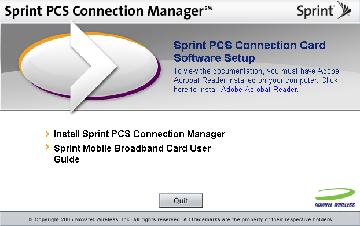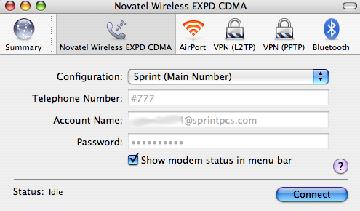
I have always suspected there was a mobile broadband solution in my future as I have been carrying my laptop all around the city for years, for both work and play. True that WiFi hotspots are becoming more common (I'm especially interested in seeing the fon community gain some traction), but my travels have been significantly restricted by the low availability of free wifi.
Now I have been a smartphone user for years both with Palm Treos and for the past year the Sprint PPC-6700 and have been paying for and using the high-speed data networks on the handheld device. It is borderline useful on the phone for browsing, email, and even IM but my real workhorse is the laptop. I did get dial-up networking (DUN) to work with my Mac using Bluetooth but this has never been satisfactory for me, mainly because of the complexity and unpredictability of the solution.
Time to Man Up
The more geekish among you may have determined that this card really hasn't been on the market that long but I have been eyeing an EVDO laptop solution for months. It wasn't until I saw the Express Card option come along that I really started to pay attention (emphasis on the "pay"). Honestly the big roadblock had been getting past the up front cost of the Novatel Wireless Merlin EX720 Rev. A ExpressCard, but I knew it would be easy to justify Sprint's ongoing service monthly charge. I am always looking for opportunities to be more productive and this relatively tiny plug-in accessory brings the Internet to me in so many more places now.
A Timely Update
Apple's most recent (at the time of this writing) software update brought the necessary support to my MacBook Pro and not a moment too soon. I stopped by the closest Sprint store, picked up the card, signed up for what is actually another mobile phone line, and walked out 15 minutes later eager to plug in and get going.
Unfortunately, there is the small bit of configuration and validation. The CD that came in the box with the card only had a Windows-compatible program and rather than fight through this on a Mac-righteous crusade, I quickly launched Windows in Parallels and stepped through the relatively painless wizard plugging in the numbers provided to me by Greg the helpful Sprint counter jockey. In no time at all I went from this

to this

Still, Windows connectivity wasn't my end goal so I disconnected and shutdown to clear the way for the Mac scenario.
Boy was I surprised, although if I were more smug I would have expected it to have just worked magically. I plugged in the card again and OS X not only recognized it, but also added it to the Internet Connect panel (see below) and it was ready to go!
Every Spot is a Now a Hot Spot

Forget hot spots, now I'm all about global warming. Ok that was admittedly corny but now high-speed Internet access is just a plug-and-click away. I haven't done any real experimentation to see if mobile broadband through the card sucks up any more battery life than the corresponding WiFi alternative but that would certainly be disappointing to discover.
For now, color me happy. Of course I can't share this card with anyone, not even other laptops I own because of the express card form factor but its not like there was a real serious alternative to the MBP anyway. I'll stop back by to share more of my experiences but if you have the same gadget-buying-rationale that I do, I can't recommend this solution enough!




